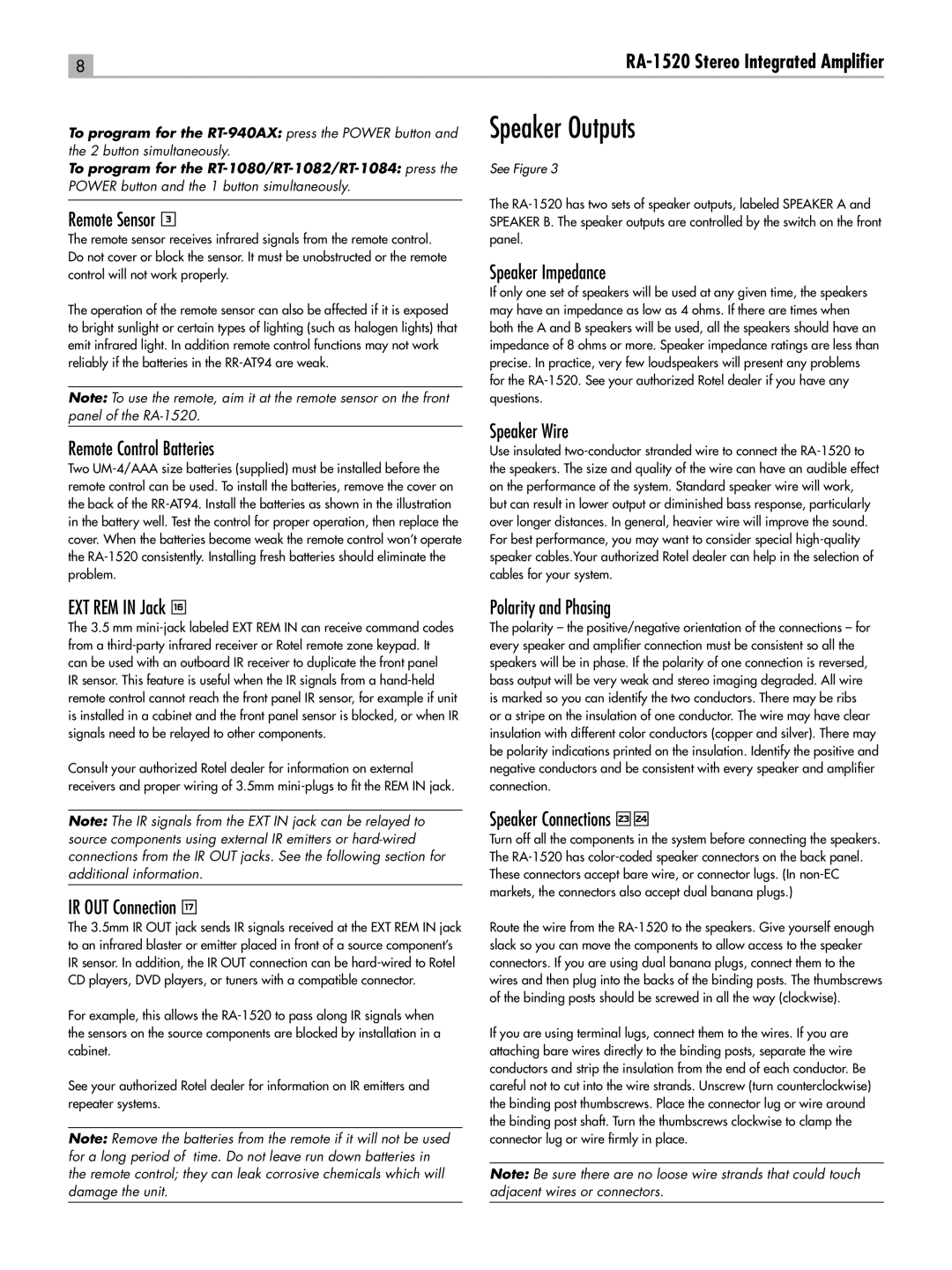To program for the RT-940AX: press the POWER button and the 2 button simultaneously.
To program for the RT-1080/RT‑1082/RT-1084: press the
POWER button and the 1 button simultaneously.
Remote Sensor 3
The remote sensor receives infrared signals from the remote control. Do not cover or block the sensor. It must be unobstructed or the remote control will not work properly.
The operation of the remote sensor can also be affected if it is exposed to bright sunlight or certain types of lighting (such as halogen lights) that emit infrared light. In addition remote control functions may not work reliably if the batteries in the RR‑AT94 are weak.
Note: To use the remote, aim it at the remote sensor on the front panel of the RA‑1520.
Remote Control Batteries
Two UM-4/AAA size batteries (supplied) must be installed before the remote control can be used. To install the batteries, remove the cover on the back of the RR‑AT94. Install the batteries as shown in the illustration in the battery well. Test the control for proper operation, then replace the cover. When the batteries become weak the remote control won’t operate the RA‑1520 consistently. Installing fresh batteries should eliminate the problem.
EXT REM IN Jack r
The 3.5 mm mini-jack labeled EXT REM IN can receive command codes from a third-party infrared receiver or Rotel remote zone keypad. It can be used with an outboard IR receiver to duplicate the front panel IR sensor. This feature is useful when the IR signals from a hand-held remote control cannot reach the front panel IR sensor, for example if unit is installed in a cabinet and the front panel sensor is blocked, or when IR signals need to be relayed to other components.
Consult your authorized Rotel dealer for information on external receivers and proper wiring of 3.5mm mini-plugs to fit the REM IN jack.
Note: The IR signals from the EXT IN jack can be relayed to source components using external IR emitters or hard-wired connections from the IR OUT jacks. See the following section for additional information.
IR OUT Connection t
The 3.5mm IR OUT jack sends IR signals received at the EXT REM IN jack to an infrared blaster or emitter placed in front of a source component’s IR sensor. In addition, the IR OUT connection can be hard-wired to Rotel CD players, DVD players, or tuners with a compatible connector.
For example, this allows the RA‑1520 to pass along IR signals when the sensors on the source components are blocked by installation in a cabinet.
See your authorized Rotel dealer for information on IR emitters and repeater systems.
Note: Remove the batteries from the remote if it will not be used for a long period of time. Do not leave run down batteries in the remote control; they can leak corrosive chemicals which will damage the unit.
Speaker Outputs
See Figure 3
The RA‑1520 has two sets of speaker outputs, labeled SPEAKER A and SPEAKER B. The speaker outputs are controlled by the switch on the front panel.
Speaker Impedance
If only one set of speakers will be used at any given time, the speakers may have an impedance as low as 4 ohms. If there are times when both the A and B speakers will be used, all the speakers should have an impedance of 8 ohms or more. Speaker impedance ratings are less than precise. In practice, very few loudspeakers will present any problems for the RA‑1520. See your authorized Rotel dealer if you have any questions.
Speaker Wire
Use insulated two-conductor stranded wire to connect the RA‑1520 to the speakers. The size and quality of the wire can have an audible effect on the performance of the system. Standard speaker wire will work, but can result in lower output or diminished bass response, particularly over longer distances. In general, heavier wire will improve the sound. For best performance, you may want to consider special high-quality speaker cables.Your authorized Rotel dealer can help in the selection of cables for your system.
Polarity and Phasing
The polarity – the positive/negative orientation of the connections – for every speaker and amplifier connection must be consistent so all the speakers will be in phase. If the polarity of one connection is reversed, bass output will be very weak and stereo imaging degraded. All wire is marked so you can identify the two conductors. There may be ribs or a stripe on the insulation of one conductor. The wire may have clear insulation with different color conductors (copper and silver). There may be polarity indications printed on the insulation. Identify the positive and negative conductors and be consistent with every speaker and amplifier connection.
Speaker Connections []
Turn off all the components in the system before connecting the speakers. The RA‑1520 has color-coded speaker connectors on the back panel. These connectors accept bare wire, or connector lugs. (In non-EC markets, the connectors also accept dual banana plugs.)
Route the wire from the RA‑1520 to the speakers. Give yourself enough slack so you can move the components to allow access to the speaker connectors. If you are using dual banana plugs, connect them to the wires and then plug into the backs of the binding posts. The thumbscrews of the binding posts should be screwed in all the way (clockwise).
If you are using terminal lugs, connect them to the wires. If you are attaching bare wires directly to the binding posts, separate the wire conductors and strip the insulation from the end of each conductor. Be careful not to cut into the wire strands. Unscrew (turn counterclockwise) the binding post thumbscrews. Place the connector lug or wire around the binding post shaft. Turn the thumbscrews clockwise to clamp the connector lug or wire firmly in place.
Note: Be sure there are no loose wire strands that could touch adjacent wires or connectors.

